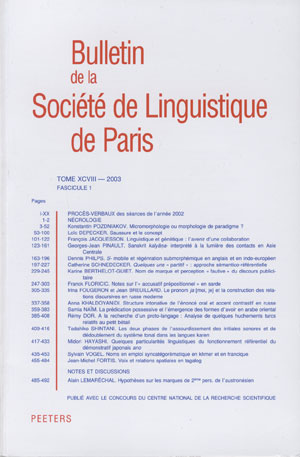 previous article in this issue previous article in this issue | next article in this issue  |

Preview first page |
Document Details : Title: Ab urbe condita Subtitle: Le participe dominant et son ellipse dans les langues baltiques Author(s): PETIT, Daniel Journal: Bulletin de la Société de Linguistique de Paris Volume: 114 Issue: 1 Date: 2019 Pages: 385-458 DOI: 10.2143/BSL.114.1.3287161 Abstract : La notion de «participe dominant» a été introduite il y a environ 50 ans pour rendre compte de la construction latine bien connue du type ab urbe condita «depuis la cité ayant été fondée» (= «depuis la fondation de la cité»). Cette construction est largement attestée en latin comme en grec et a laissé des traces significatives en gotique, mais on sait moins qu’elle a existé aussi en vieux lituanien, avec des restrictions spécifiques qui l’ont rapprochée plus étroitement de la construction du datif absolu. L’objet du présent article est de décrire l’extension du type ab urbe condita en baltique et de proposer une interprétation de sa structure à la lumière de ces données nouvelles. The notion of ‘dominant participle’ was introduced some 50 years ago to account for the well-known Latin construction of the type ab urbe condita ‘from the city having been founded’ (= ‘from the founding of the city’). This construction is widely attested in Latin as well as in Greek and has also left significant relics in Gothic, but it is less known that it has existed in Old Lithuanian as well, with specific limitations that brought it closer to the dative absolute construction. The aim of this paper is to describe the extension of the ab urbe condita-type in Baltic and to propose an interpretation of its structure in the light of these new data. Der Begriff vom ‘dominanten Partizip’ wurde vor etwa 50 Jahren eingeführt, um die wohlbekannte lateinische Konstruktion des Typs ab urbe condita ‘von der gegründeten Stadt an’ (mit der Bedeutung ‘von der Gründung der Stadt an’) zu erklären. Diese Konstruktion ist im Lateinischen und im Griechischen sehr gut belegt und hat deutliche Spuren im Gothischen hinterlassen. Weniger bekannt ist, dass sie auch im Altlitauischen existiert hat, wo sie eigenartige Beschränkungen aufweist, die sie der absoluten Konstruktion mit dem Dativ näher gebracht haben. Ziel dieses Aufsatzes ist es, die Ausdehnung des ab urbe condita-Typs im Baltischen zu beschreiben und im Lichte dieser neuen Daten eine Auslegung seiner Struktur vorzuschlagen. |
|


